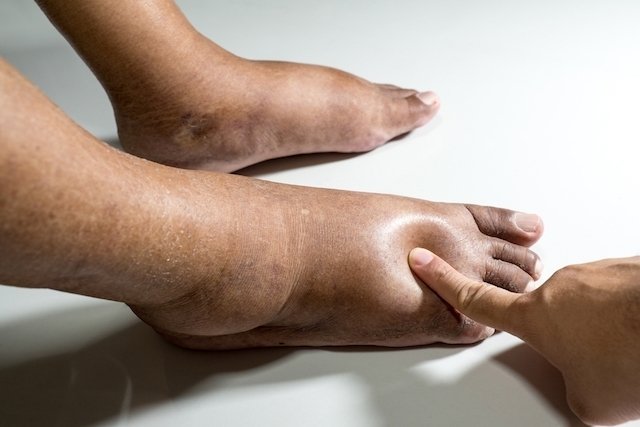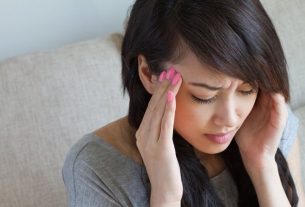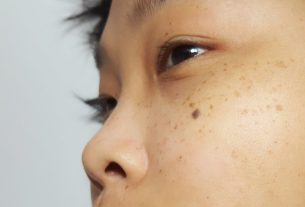Poor circulation is a situation characterized by difficulty for blood to pass through the veins and arteries, and can be identified through the appearance of some signs and symptoms, such as cold feet, swelling, tingling sensations and drier skin, for example.
Poor circulation can happen due to the use of contraceptive pills, being overweight, aging or being a consequence of standing for a long time or with your legs crossed, for example.
It is important that the cause of poor circulation is identified, as well as the symptoms that are present and the frequency with which they appear, as this way it is possible for the angiologist, cardiologist or general practitioner to indicate the most appropriate treatment to help alleviate the symptoms.

Symptoms of poor circulation
The main symptoms of poor circulation in the legs are:
- Cold, dry or scaly skin;
- Itchy legs;
- Red spots on the legs;
- Presence of spider veins or varicose veins;
- Swollen feet and ankles;
- Pale or bluish color in places with poor circulation;
- Leg cramps;
- Stinging sensation, numbness or tingling in the legs;
- Absence of hair on the legs;
- Cracked heels.
Symptoms usually worsen at the end of the day, especially when the person has spent a lot of time standing, but they can also occur with greater intensity during the menstrual cycle, during hotter periods of the day or when wearing high heels or flat sandals.
How to confirm the diagnosis
The diagnosis of poor circulation in the legs is made by the angiologist or cardiologist initially based on the assessment of the signs and symptoms presented by the person and clinical and family history. Your doctor may also recommend a Doppler ultrasound to evaluate the blood flow between the arteries and veins, which helps to make an initial diagnosis of the cause of poor circulation.
Make an appointment with your nearest doctor to carry out an assessment and identify the possible cause of poor circulation:
Taking care of your health has never been easier!
Main causes
The main causes of poor circulation in the legs are:
1. Pregnancy
During pregnancy, a woman’s body produces more fluids to maintain irrigation of the placenta, which makes it difficult for the veins to work. Furthermore, during pregnancy, the hormone relaxin is produced, which causes the veins to dilate, making it difficult for blood to return to the heart.
2. Atherosclerosis
Atherosclerosis is a condition in which there is the deposition of fatty plaques within the arteries, which directly interferes with blood circulation, which becomes more difficult, causing the symptoms of poor circulation to appear.
3. Excess weight and sedentary lifestyle
Excess weight and a sedentary lifestyle can compromise blood circulation in the body and make venous return more difficult, which can make the legs more swollen and tired.
4. Aging
Aging is a natural cause of poor circulation, because as a person ages, there is a loss of elasticity in blood vessels, interfering with circulation and causing the appearance of symptoms of poor circulation.
5. Use of contraceptives
Due to the amount of hormones present in the contraceptive, there may be an increased risk of thrombus formation in some women, which can directly interfere with circulation. Find out more about contraceptive thrombosis.
6. Standing for a long time
Standing, sitting or with your legs crossed for a long time, due to work or long trips, for example, can lead to poor circulation, as these situations can make the return of blood to the heart more difficult.
7. Chronic illnesses
Some chronic diseases, such as hypertension and diabetes, can result in poor circulation, especially when they are not treated correctly.
How the treatment is carried out
To combat and avoid the symptoms of poor circulation in the legs, it is important to follow the instructions of an angiologist, cardiologist or general practitioner, who may recommend the use of compression stockings or medications that act on the veins of the circulatory system, improving venous tone, microcirculation and blood vessel resistance.
Taking measures, such as elevating your legs at the end of the day, taking a shower with water at a medium temperature, massaging from the ankle to the groin and wearing comfortable shoes, also help to reduce the discomfort caused by poor circulation.
In addition, regular physical activity and a diet low in salt and rich in vitamin C and antioxidants can also help to avoid and combat the symptoms of poor circulation, as can some home remedies, such as orange juice with parsley and pineapple juice with ginger, for example. Check out other home remedy options for poor circulation.
Also see the following video for some other tips to reduce foot swelling:
Bibliography
- SPANISH COMMUNITY PHARMACY SOCIETY. PRACTICAL GUIDE TO PREVENT AND TREAT TIRED LEGS SYNDROME. 2017. Available at: <https://www.sefac.org/sites/default/files/2017-11/Sind__piernas_cansadas>. Accessed on March 15, 2022
- Dr. Eduardo Carrasco Carrasco Dr. Santiago Díaz Sánchez. Recommendations for the management of Chronic Venous Disease in Primary Care. edic id. Spain: Medical ID, 2015.
- GENERAL NURSING COUNCIL. Leg health and chronic venous insufficiency. Available at: <https://www.consejogeneralenfermeria.org/docs_revista/Dossier_Salud_de_las_Piernas_e_IVC_Cinfa.pdf>. Accessed on March 15, 2022
- Mercè Piera Fernández. Tired legs. ELSEVIER. 2002

Sign up for our newsletter and stay up to date with exclusive news
that can transform your routine!
Warning: Undefined array key "title" in /home/storelat/public_html/wp-content/plugins/link-whisper-premium/templates/frontend/related-posts.php on line 12
Warning: Undefined array key "title_tag" in /home/storelat/public_html/wp-content/plugins/link-whisper-premium/templates/frontend/related-posts.php on line 13




